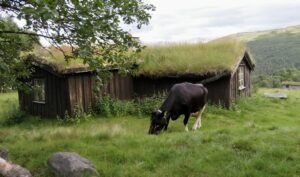
Exploring Norse Mythological Creatures & Lore
Hold on tight as we embark on a journey through the enchanting realm of Norse mythology. Brace yourself to encounter an array of extraordinary beings, as we shine a light on the fascinating creatures that inhabit the rich tapestry of Norse lore. From fearsome giants and cunning tricksters to majestic dragons and divine beings, delve into the world of Norse mythological creatures and discover the legends that have captivated generations.
But have you ever wondered about the origins and significance of these ancient creatures? Are they mere figments of imagination or do they hold a deeper meaning? What mystical stories lie beneath the surface of these mythical beings? Join us as we unlock the mysteries and challenge common beliefs surrounding Norse mythological creatures.
Table of Contents
ToggleKey Takeaways:
- Explore the magical world of Norse mythology and its captivating creatures.
- Discover the prominent role of giants, dragons, and tricksters in Norse folklore.
- Uncover the stories and symbolism behind these legendary beings.
- Learn about the powerful gods and goddesses that shape Norse mythology.
- Journey through the realms of Norse folklore and encounter various mythical creatures.
The Mighty Jotnar: Giants of Norse Mythology
In the rich tapestry of Norse mythology, the Jotnar, also known as giants, play a prominent role. These majestic beings, born from the primordial Ymir, inhabit the realms of ice and fire, towering over the mortal world with their immense size and power. With their elemental origins and varied appearances, the Jotnar are a fascinating part of Norse folklore.
In Norse mythology, the Jotnar are not merely monstrous creatures; they possess complex personalities and often interact with the gods, humans, and other creatures. Some Jotnar are depicted as wise and benevolent, while others are more unpredictable and antagonistic. Their interactions range from peaceful alliances to fierce battles, shaping the destiny of gods and mortals alike.
“Lo, Earth! she fell not, though struck by Jotun, “Roaring Wood,” in fiercest of battles.”
Types of Jotnar
Within the realm of Norse mythology, different types of Jotnar exist, each with its own characteristics and stories. Here are some of the notable Jotnar:
- Thursar: These giants are associated with brute strength and chaos. They often clash with the gods, representing the forces of chaos that threaten order in the cosmos.
- Bergelmir: As the descendant of Ymir, Bergelmir survived the Great Flood that wiped out the Jotnar. He, along with his wife, became the progenitors of a new race of giants.
- Frost Giants: Known for their affinity with ice and frost, these Jotnar are powerful adversaries of the gods, frequently depicted as formidable opponents in Norse mythological tales.
Stories and Legends
The stories and legends surrounding the Jotnar are numerous and captivating. One of the most famous Jotnar is Ymir, the primordial giant whose body formed the world. Another well-known Jotnar is Skrymir, a giant encountered by Thor during his ventures, leaving a lasting impression.
One particularly compelling tale involves the Jotun Loki. Although typically associated with trickery and mischief, Loki embraces his Jotnar heritage and demonstrates his shapeshifting abilities in various adventures, including giving birth to the eight-legged horse Sleipnir.
Jotnar in Popular Culture
The allure of the Jotnar extends beyond ancient mythology. These captivating giants have been featured in numerous works of literature, games, and movies, captivating audiences with their immense power and grandeur. From Neil Gaiman’s novel “Norse Mythology” to Marvel’s cinematic universe, the Jotnar continue to leave an indelible mark on popular culture.
| Jotnar | Description |
|---|---|
| Ymir | The primordial giant whose body formed the world. |
| Skrymir | The giant encountered by Thor during his ventures, leaving a lasting impression. |
| Loki | The trickster shapeshifter associated with the Jotnar. |
These are just a few examples of the prominent Jotnar in Norse mythology. Their presence in various forms of media ensures that their legacy continues to captivate audiences around the world.
Mythical Beasts: Dragons and Serpents in Norse Mythology
Dragons and serpents, legendary creatures that evoke awe and fear, hold a prominent place in Norse mythology. These formidable beings permeate the tapestry of Scandinavian mythical tales, captivating the imaginations of both ancient and modern audiences.
In Norse myth, dragons and serpents symbolize power, chaos, and the eternal struggle between good and evil. They embody the raw forces of nature and serve as guardians of hidden knowledge and treasure.
One of the most iconic dragons in Norse mythology is Jormungandr, also known as the World Serpent. This colossal creature, a child of Loki, wraps around the world and bites its own tail. According to prophecy, Jormungandr will play a cataclysmic role during Ragnarok, the apocalyptic battle that ends the cycle of Norse cosmology.
“Jormungandr’s immense size and its symbolic ties to the world’s destruction highlight the profound impact of dragons and serpents in Norse mythology,”
Another famous serpent is Nidhogg, a fearsome creature that gnaws at the roots of Yggdrasil, the World Tree. Nidhogg represents the constant threat of chaos and destruction in the Nine Realms, seeking to undermine the order of the cosmos.
The tales of dragons and serpents in Norse mythology not only fascinate with their mythical creatures but also carry deep cultural and metaphorical meanings. These creatures embody the struggles and mysteries of the Norse worldview, reminding us of the eternal battles fought between light and darkness, order and chaos.
Mystical beings of fire and water
The dragons and serpents in Norse mythology come in various forms and elements, each with their unique characteristics and symbolism. The fiery dragon Fafnir, for instance, demonstrates the destructive power of greed and lust for wealth. In contrast, the benevolent sea serpents, such as the Kraken and the Midgard Serpent, represent the unpredictable but life-giving forces of the vast oceans.
Whether dragging the sun across the sky, guarding hordes of gold, or arising from the depths of the sea, dragons and serpents in Norse mythology continue to captivate our imagination. Their enduring presence in tales and artwork throughout history testifies to the compelling allure of these mythical beasts.
Shapeshifters and Tricksters: Norse Mythological Creatures
In the rich tapestry of Norse mythology, a captivating array of shapeshifters and tricksters exist, weaving tales that enchant and deceive. These Norse folklore creatures, known for their cunning nature and ability to transform, play intriguing roles in the legends and stories passed down through generations.
Gleipnir: The Unbreakable Binding
One notable shapeshifter in Norse mythology is the wolf Fenrir. According to legend, the gods feared the ferocious nature of Fenrir and sought to restrain him. To achieve this, they enlisted the help of the dwarves, who created Gleipnir, an unbreakable and seemingly insignificant binding.
Fenrir, unaware of the true nature of the binding, agreed to allow the gods to secure him with Gleipnir. However, the wolf soon realized he had been tricked and, in a desperate rage, bit off the hand of the god Tyr, who had placed his hand in Fenrir’s mouth as a sign of good faith.
This tale showcases the cunning and deceptive strategies employed by Norse tricksters, highlighting their ability to outwit even the mightiest of creatures.
Loki: The Shape-shifting Deceiver
No discussion of Norse mythology would be complete without mentioning Loki, the infamous trickster god. Known for his shape-shifting abilities, Loki often took on different forms to deceive both gods and mortals alike.
In some tales, Loki transformed into animals such as a fly, a salmon, or even a mare to achieve his mischievous aims. His cunning nature and ability to disguise himself allowed him to navigate both the realms of gods and mortals, often sowing chaos and causing disruptions.
However, Loki’s cleverness was not without consequences. His trickery ultimately led to dire consequences and sparked a chain of events that brought about the beginning of Ragnarok, the prophesied end of the world in Norse mythology.
These tales of shapeshifters and tricksters in Norse mythology serve as cautionary reminders of the unpredictability and deceptive powers that can exist even in the most magical realms. From Fenrir’s betrayal to Loki’s cunning, these Norse folklore creatures continue to captivate and fascinate audiences with their intriguing stories.
Divine Creatures: Gods and Goddesses in Norse Mythology
Step into the mystical realm of Norse mythology and encounter a pantheon of divine beings. These gods and goddesses hold immense power and influence over the world and its creatures, shaping the very fabric of Norse folklore and legends.
The Allfather: Odin
At the forefront of the Norse gods stands Odin, the wise and mighty Allfather. He is the ruler of Asgard, the realm of the gods, and the master of wisdom, warfare, and magic. Odin’s commanding presence and unwavering knowledge make him a central figure in Norse mythology.
The Thunderer: Thor
No discussion of Norse mythology would be complete without Thor, the god of thunder. Known for his incredible strength and bravery, Thor wields the mighty Mjolnir, a magic hammer that can summon thunder and lightning. He is a guardian of both gods and humans, defending them against the forces of chaos.
The Beautiful Freya
Freya, the goddess of love, beauty, and fertility, captivates with her grace and allure. As a powerful and independent deity, she holds control over desires and passions, guiding the course of love and longing in the Norse cosmos.
The Wise Freyja
Often associated with beauty and fertility, Freyja, the goddess of love, also possesses great wisdom and cunning. She is a skilled practitioner of magic and holds dominion over war and death, representing the complex nature of life and the cyclical aspects of the human experience.
These divine beings serve as both protectors and source of inspiration for the people of Norse mythology. Their stories and actions shape the world and its creatures, intertwining mortal and immortal realms.
The Trickster: Loki
Intriguing and enigmatic, Loki is the mischievous trickster god of Norse mythology. With his shape-shifting abilities and cunning intelligence, he walks a fine line between chaos and order. Loki’s unpredictable nature adds complexity and unpredictability to the pantheon of Norse gods.
The Goddess of Home and Hearth: Frigg
Frigg, the goddess of marriage, motherhood, and the hearth, is a nurturing and protective deity. She symbolizes the warmth and stability of home, ensuring domestic harmony and safeguarding familial bonds in the Norse cosmology.
| Gods | Domains |
|---|---|
| Odin | Wisdom, War, Magic |
| Thor | Thunder, Protection |
| Freya | Love, Beauty, Fertility |
| Freyja | Wisdom, Magic, War |
| Loki | Mischief, Chaos |
| Frigg | Marriage, Motherhood, Hearth |
The gods and goddesses of Norse mythology bring a rich tapestry of divine beings that reflect aspects of the human experience. From wisdom and strength to love and trickery, these divine creatures fascinate and inspire, continuing to captivate audiences today.
Legendary Creatures: Beings from Norse Folklore
Step into the enchanting realms of Norse folklore, where a captivating array of legendary creatures await. These mythical beings from the depths of Scandinavian mythology have stirred the imaginations of generations, leaving an indelible mark on tales passed down through the ages.
The Fearsome Jörmungandr
One of the most legendary creatures to emerge from Norse lore is the mighty Jörmungandr. Often referred to as the Midgard Serpent, this colossal sea serpent encircles the world, growing with such immense size that it can bite its own tail. As a symbol of chaos and destruction, Jörmungandr poses a constant threat to both gods and humans in the Norse pantheon.
The Cunning Fenrir
Another legendary creature of Norse mythology is the fearsome wolf known as Fenrir. As the son of the trickster god Loki, Fenrir embodies both power and cunning. It is said that he will ultimately break free from his restraints and bring about the cataclysmic event known as Ragnarok, signaling the end of the world.
The Elusive Huldra
Exploring the realm of woodland spirits, we encounter the Huldra, a seductive and mystical creature from Norse folklore. These elusive beings possess ethereal beauty, often luring unsuspecting individuals deeper into the forest. While their intentions can range from mischievous to malicious, encounters with the Huldra are always filled with enchantment and danger.
The Mysterious Nøkken
Roaming the waterways of Norse mythology, the Nøkken is a shape-shifting creature that is both alluring and deadly. Often taking the form of a beautiful horse or a mesmerizing musician, this creature dwells in lakes and rivers, using its captivating presence to lure unsuspecting victims to their watery demise.
| Legendary Creature | Description |
|---|---|
| Jörmungandr | A colossal sea serpent that encircles the world, posing a threat to gods and humans alike. |
| Fenrir | A powerful wolf, son of Loki, destined to bring about the end of the world. |
| Huldra | A seductive woodland creature known for luring unsuspecting individuals deeper into the forest. |
| Nøkken | A shape-shifting creature that dwells in lakes and rivers, using its mesmerizing presence to lure victims. |
These legendary creatures from Norse folklore are just a taste of the rich tapestry of beings that inhabit the mythological landscapes of Scandinavia. Their captivating stories continue to awe and inspire, reminding us of the enduring power of myth and the eternal fascination with the unknown.
Conclusion
As we conclude our exploration of Norse mythological creatures and lore, we are left in awe of the rich and enchanting world that has captivated audiences for centuries. From the towering Jotnar giants to the fearsome dragons and serpents, the mythical beings of Norse mythology have fascinated and inspired countless tales and legends.
Not to be forgotten are the shapeshifters and tricksters, who add an element of mischief and intrigue to the stories. These creatures, with their ability to assume various forms and deceive, are both captivating and unpredictable.
And let us not overlook the divine creatures, the gods and goddesses who shape the world and its inhabitants. These powerful beings wield immense influence and provide the backdrop for the mythological tapestry of Norse lore.
From the realms of folklore to the legendary creatures that abound, Norse mythology takes us on a journey that is as captivating as it is inspiring. The stories and legends continue to be told and cherished, reminding us of the enduring power of mythology and the timeless appeal of these extraordinary creatures.
FAQ
What are some examples of Norse mythological creatures?
What role do giants play in Norse mythology?
What are some legendary creatures from Norse folklore?
Which gods and goddesses are significant in Norse mythology?
What are some stories about dragons in Norse mythology?
Are there any mythical beasts in Norse folklore?
If you want to learn Norwegian, you can register for classes here. We look forward to hearing from you and helping you become fluent in Norwegian.





